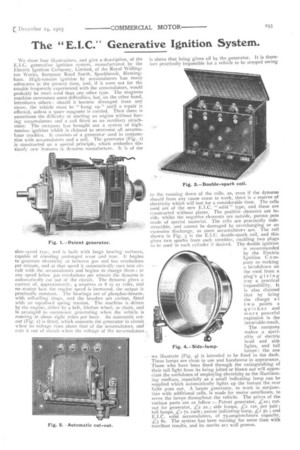The "E.I.C." Generative Ignition System.
Page 19

If you've noticed an error in this article please click here to report it so we can fix it.
We show four illustrations, and give a description, of the E.I.C. generative ignition system, manufactured by the Electric Ignition Company, Limited, of the Royal Wellington Works, Sampson Road North, Sparkbrook, Birmingham. High-tension ignition by accumulators has many advocates at the present time, and, if it were not for the trouble frequently experienced with the accumulators, would probably be more used than any other type. The magneto machine overcomes some difficulties, but, on the other hand, introduces others : should it become deranged from any cause, the vehicle must be " hung up " until a repair is effected, unless a spare magneto is carried. Then there is sometimes the difficulty of starting an engine without having accumulators and a coil fitted as an auxiliary attachment. The company has brought out a system of hightension ignition which is claimed to overcome all accumulator troubles. It consists of a generator used in conjunction with accumulators and a coil. The generator (Fig. i) is constructed on a special principle, which embodies distinctly new features in dynamo manufacture. It is of the slow-speed type, and is built with large bearing surfaces, capable of standing prolonged wear and tear. It begins to generate electricity at between 500 and boo revolutions per minute, and at that speed it automatically cuts into circuit with the accumulators and begins to charge them : at any speed below soo revolutions pee minute the dynamo is automatically cut out of the circuit. The dynamo gives a current of, approximately, 4 amperes at S to 22 volts, and no matter how the engine speed is increased, the output is practically constant. The bearings are of phosphor-bronze, with self-oiling rings, and the brushes are carbon, fitted with an equalised spring tension. The machine is driven by the engine, either by a belt, friction wheel, or chain, and is arranged to commence generating when the vehicle is running at about eight miles per hour. An automatic cutout (Fig. 2) is fitted, which connects the generator in circuit w hen its voltage rises above that of the accumulators, and cuts it out of circuit when the voltage of the accumulators
is above that being given off by the generator. It is therefore practically impossible for a vehicle to be stopped owing
to the running down of the cells, as, even if the dynamo should from any cause cease to work, there is a reserve of electricity which will last for a considerable time. The cells used are of the new E.I.C. " solid " type, and these are constructed without plates. The positive elements are inside. whilst the negative elements are outside, porous pots made of special material. The cells are practically indestructible, and cannot be damaged by overcharging or an excessive discharge, as most accumulators are. The coil shown in Fig. 3 is the E.I.C. double-spark coil, and this gives two sparks from each trembler, enabling two plugs to be used in each cylinder if desired. The double ignition is recommended by the Electric Ignition C o inpany as making a breakdown on the road from a plug's giving way a practical impossibility. It is also claimed that by firing the charge a t two points a quicker and in o r e powerful explosion is the invariable result.
The company makes a speciality of electric head and side lights, and tail lamps : the one we illustrate (Fig. 4) is intended to be fixed to the dash. These lamps are clean in use and handsome in appearance. Those who have been fined through the extinguishing of their tail light from its being jolted or blown out will appreciate the usefulness of employing electricity as the illuminating medium, especially as a small indicating lamp can be supplied which automatically lights up the instant the rear light goes out. A larger generator, to work in conjunction with additional cells, is made for motor omnibuses, to serve the lamps throughout the vehicle. The prices of the various parts are as follow :—Patent generator, 'io; cutout for generator, L:2 2s.; side lamps, .4:2 12S. per pair; tail lamps, 7s. each; patent indicating lamp, Li as.; and E.I.C. solid accumulators, of 75-ampere-hours capacity, Z'3 Ss. The system has been running for some time with excellent results, and its merits ar;.: well proven. Fig. 4.-Side-lamp.
























